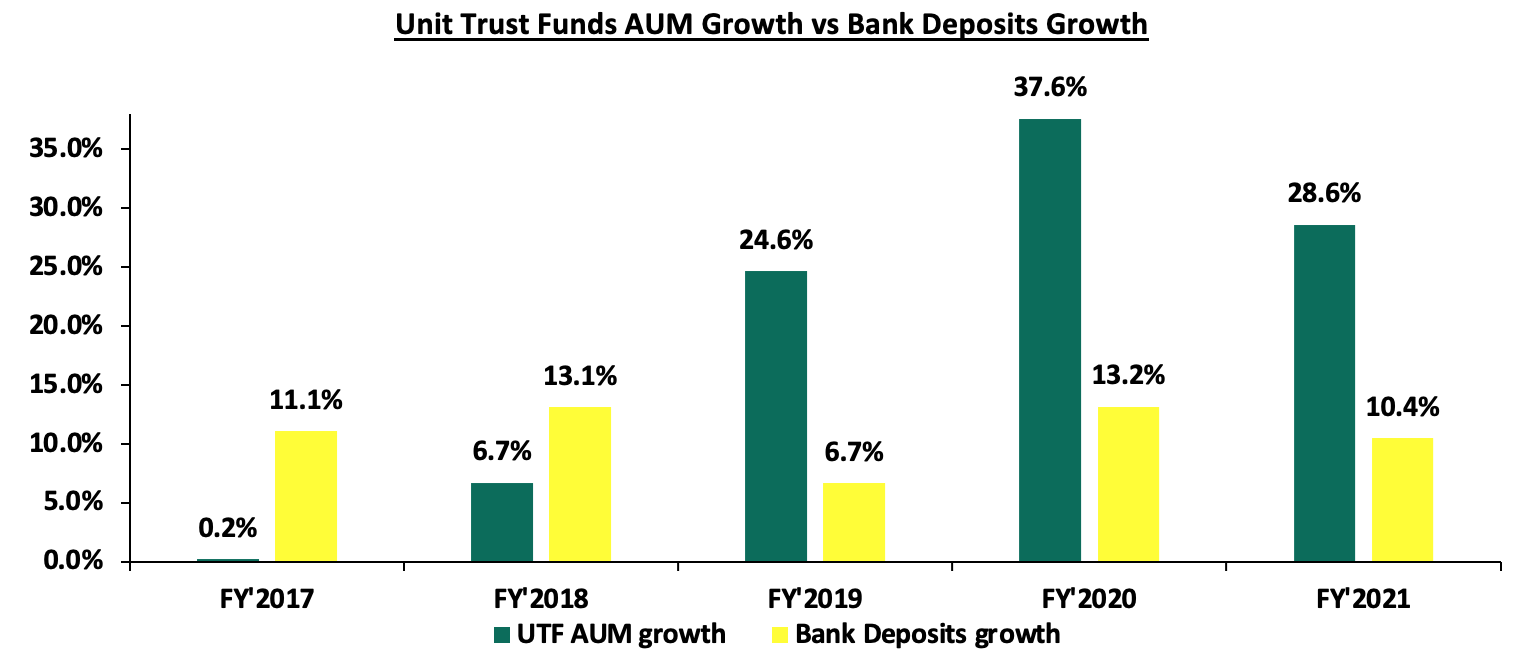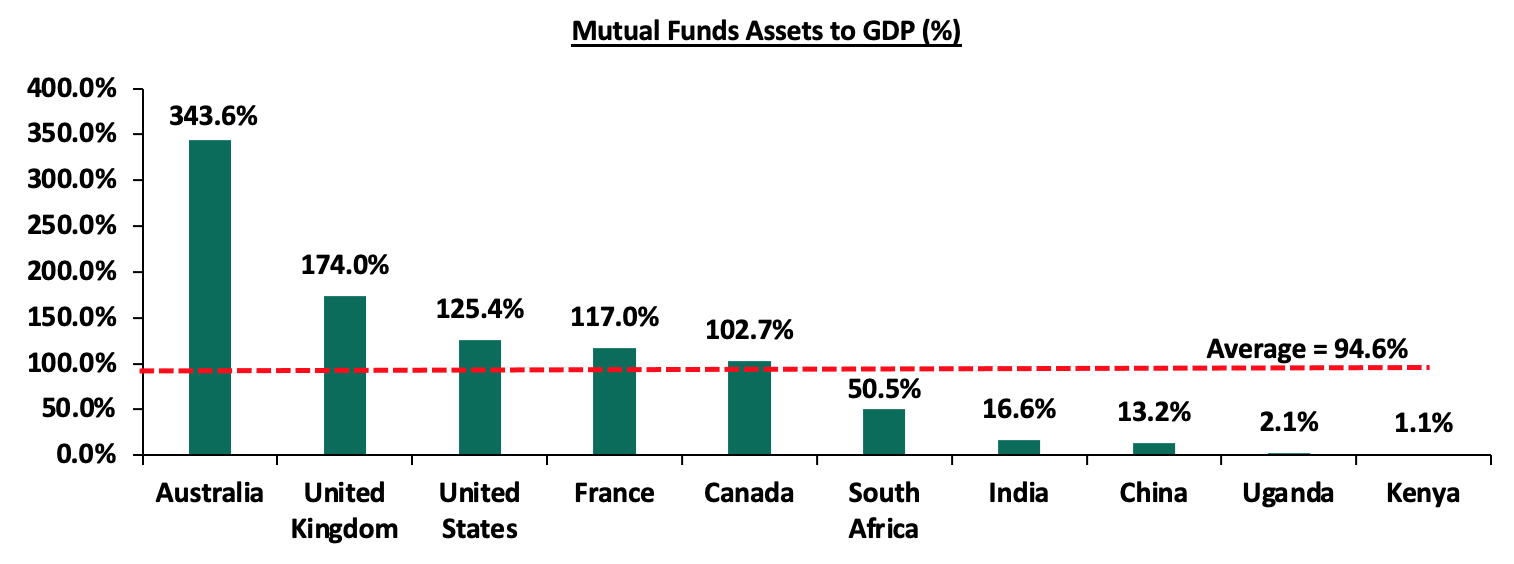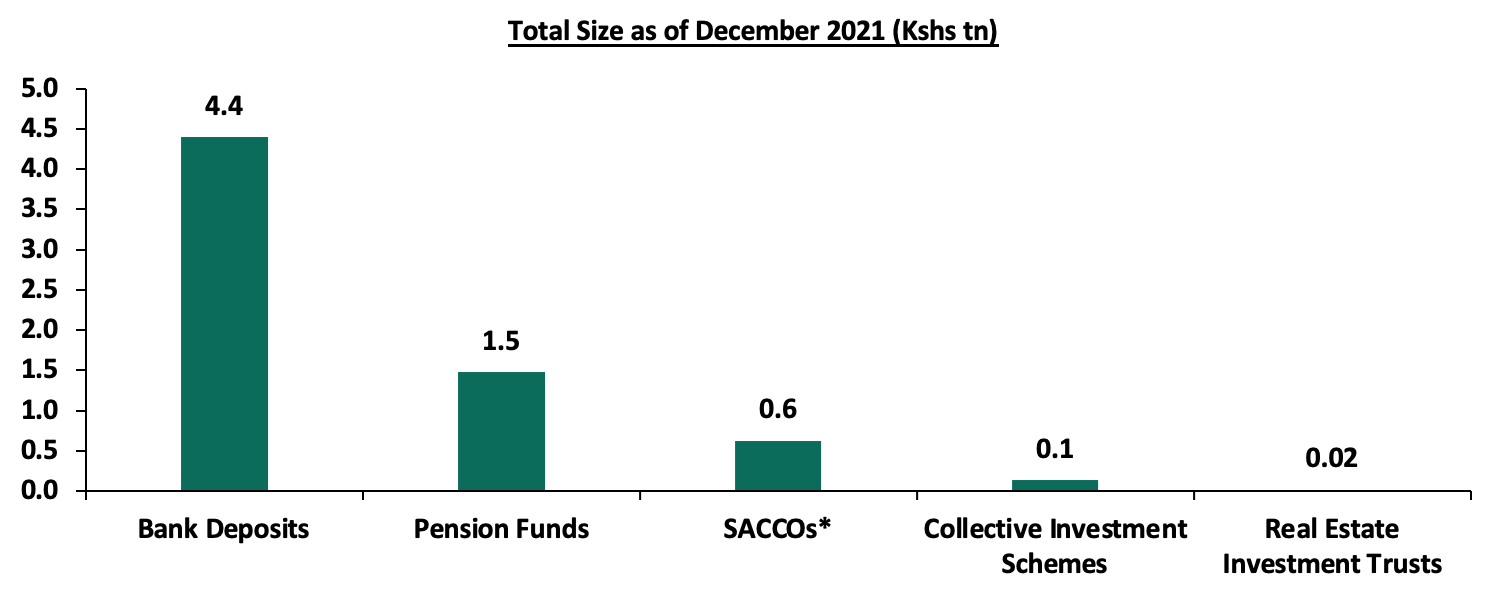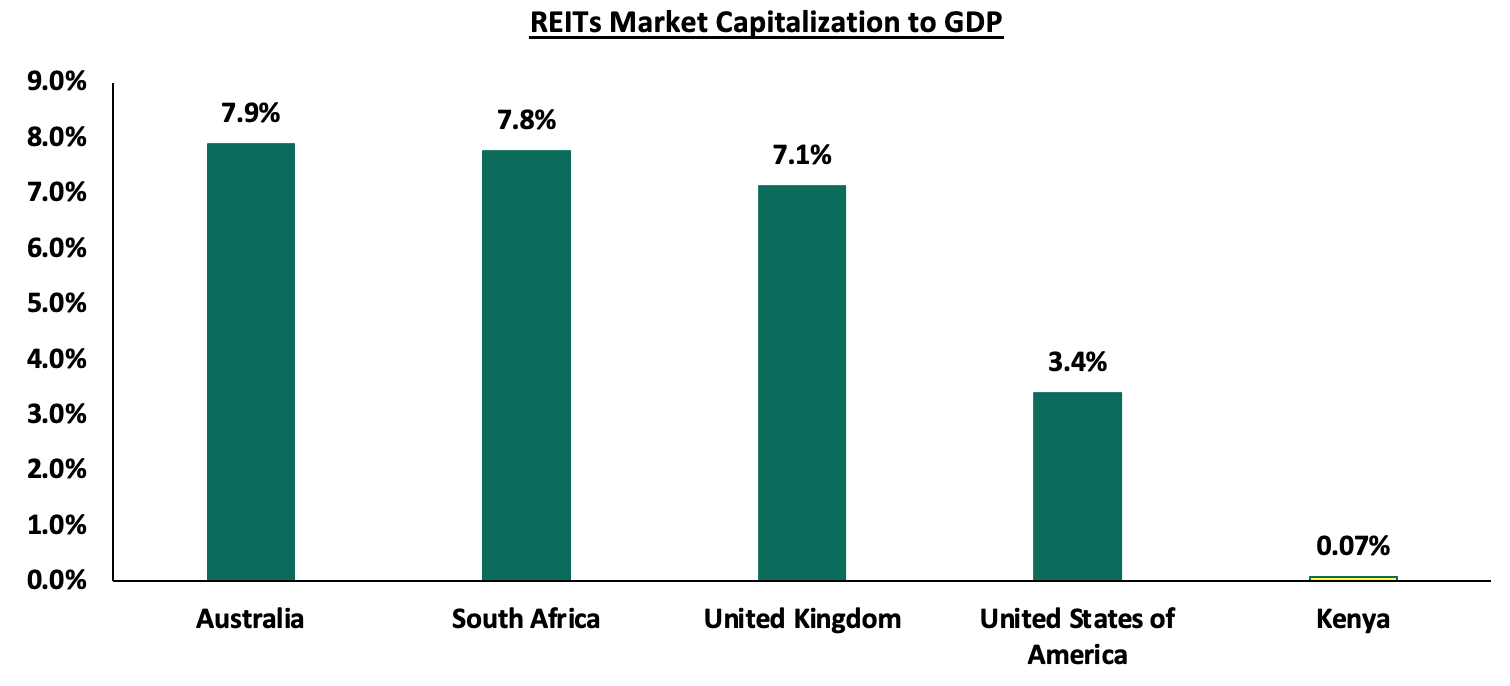May 1, 2022
Unit Trust Funds (UTFs) are Collective Investment Schemes that pool funds from different investors and are managed by professional fund managers. The fund managers invest the pooled funds in a portfolio of securities with the aim of generating returns to meet the specific objectives of the fund. Following the release of the Capital Markets Authority (CMA) Quarterly Statistical Bulletin – FY’2021, we analyze the performance of Unit Trust Funds, as the total Assets Under Management (AUM) have been steadily increasing, and they are among the most popular investment options in the Kenyan market. In our previous focus on Unit Trust Funds, we looked at the Q3'2021 Unit Trust Funds Performance by Fund Managers. In this topical, we focus on the FY’2021 performance of Unit Trust Funds where we shall analyze the following:
- Performance of the Unit Trust Funds Industry,
- Performance of Money Market Funds,
- Comparing Unit Trust Funds AUM Growth with other Markets, and,
- Recommendations
Section I: Performance of the Unit Trust Funds Industry
Unit Trust Funds are investment schemes that pool funds from investors and are managed by professional Fund Managers. The fund manager invests the pooled funds with the aim of generating returns in line with the specific objectives of the fund. The Unit Trust Funds earn returns in the form of dividends, interest income, rent and/or capital gains depending on the underlying security. The main types of Unit Trust Funds include:
- Money Market Funds – These are funds that invests in fixed income securities such as fixed deposits, treasury bills and bonds, commercial papers, etc. They are very liquid, have stable returns, and, they are suitable for risk averse investors,
- Equity Funds – These are funds which largely invest in listed securities and seek to offer superior returns over the medium to long-term by maximizing capital gains and dividend income. The funds invest in various sectors to reduce concentration risk and maintain some portion of the fund’s cash in liquid fixed income investments to maintain liquidity and pay investors if need be without losing value,
- Balanced Funds – These are funds whose investments are diversified across the Equities and the Fixed Income market. The Balanced Fund offers investors long-term growth as well as reasonable levels of stability of income,
- Fixed Income Funds – These are funds which invest in interest-bearing securities, which include treasury bills, treasury bonds, preference shares, corporate bonds, loan stock, approved securities, notes and liquid assets consistent with the portfolio’s investment objective, and,
- Sector Specific Funds – These are funds that invest primarily in a particular sector or industry. The funds provide a greater measure of diversification within a given sector than may be otherwise possible for the other funds. They are specifically approved by the capital Markets Authority as they are not invested as per the set rules and regulations.
As per the Capital Markets Authority (CMA) Quarterly Statistical Bulletin – Q1’2022, the industry’s overall Assets under Management (AUM) grew by 28.6% to Kshs 134.7 bn as at the end of FY’2021, from Kshs 104.7 bn as at the end of FY’2020. Additionally, the UTFs AUM has grown at a 4-year CAGR of 23.9% to Kshs 134.7 bn in FY’2021, from Kshs 57.2 bn recorded in FY’2017 as highlighted in the graph below:

Source: Capital Markets Authority Quarterly Statistical bulletins
This growth can be largely attributable to:
- Low Investments minimums for plain vanilla funds: Majority of the Unit Trust Funds Collective Investment Schemes’ (CIS) in the market require a relatively low initial investment ranging between Kshs 100.0 - Kshs 10,000.0. This has in turn made them attractive to retail and individual investors, boosting their growth,
- Increased Investor Knowledge: There has been a drive towards investor education on the various products offered by trust funds which has meant that more people are aware and have a deeper understanding of the investment subject. As a result, their confidence has been boosted resulting to increased uptake,
- Diversified product offering: Unit Trust Funds are also advantageous in terms of providing investors with access to a wider range of investment securities through pooling of funds. This allows investors the opportunity of diversifying their portfolios which would have not been accessible if they invested on their own,
- Efficiency and ease of access to cash/High Liquidity: Funds invested in UTFs are invested as portfolios with different assets and the fund managers always maintain a cash buffer. Unit trusts are highly liquid, as it is easy to sell and buy units without depending on demand and supply at the time of investment or exit, and,
- Adoption of Fintech: Digitization and automation within the industry has enhanced liquidity, enabling investors to receive their funds within 3 to 5 working days if they are withdrawing to their bank accounts, and immediate access to funds when withdrawing via M-PESA. According to the Central Bank of Kenya, more and more individuals are transacting through mobile money services as evidenced by the increase in the total number of registered mobile money accounts to 68.0 mn in December 2021, from 37.4 mn recorded in December 2017. Fintech has increased the efficiency of processing both payments and investments for fund managers and made Collective Investment Schemes more accessible to retail investors.
According to the Capital Markets Authority, as at the end of FY’2021, there were 29 approved Collective Investment Schemes in Kenya, up from the 23 that were recorded at the end of FY’2020. Out of the 29 however, only 19 were active while 10 were inactive. The table below outlines the performance of the Collective Investment Schemes:
|
Assets Under Management (AUM) for the Approved Collective Investment Schemes |
||||||
|
No. |
Collective Investment Schemes |
FY’2020 AUM (Kshs mn) |
FY’2020 Market Share |
FY’2021 AUM (Kshs mn) |
FY’2021 Market Share |
AUM Growth FY'2020 -FY'2021 |
|
1 |
CIC Unit Trust Scheme |
42,988.1 |
41.1% |
56,278.4 |
41.8% |
30.9% |
|
2 |
NCBA Unit Trust Scheme |
12,543.2 |
12.0% |
18,003.0 |
13.4% |
43.5% |
|
3 |
Britam Unit Trust Scheme |
12,304.8 |
11.8% |
14,573.3 |
10.8% |
18.4% |
|
4 |
ICEA Lion Unit Trust Scheme |
11,521.0 |
11.0% |
13,350.7 |
9.9% |
15.9% |
|
5 |
Sanlam Unit Trust Scheme |
6,279.8 |
6.0% |
8,610.7 |
6.4% |
37.1% |
|
6 |
Old Mutual Unit Trust Scheme |
6,131.3 |
5.9% |
6,655.0 |
4.9% |
8.5% |
|
7 |
Dry Associates Unit Trust Scheme |
2,360.9 |
2.3% |
3,054.4 |
2.3% |
29.4% |
|
8 |
Co-op Unit Trust Scheme |
1,007.1 |
1.0% |
2,801.0 |
2.1% |
178.1% |
|
9 |
Madison Asset Unit Trust Fund |
1,928.6 |
1.8% |
2,660.2 |
2.0% |
37.9% |
|
10 |
Nabo Capital (Centum) |
1,654.8 |
1.6% |
2,398.3 |
1.8% |
44.9% |
|
11 |
Zimele Unit Trust Scheme |
1,420.4 |
1.4% |
1,992.5 |
1.5% |
40.3% |
|
12 |
African Alliance Kenya |
1,813.3 |
1.7% |
1,788.4 |
1.3% |
(1.4%) |
|
13 |
Apollo Unit Trust Scheme |
587.3 |
0.6% |
716.3 |
0.5% |
22.0% |
|
14 |
Cytonn Unit Trust Scheme |
819.5 |
0.8% |
704.2 |
0.5% |
(14.1%) |
|
15 |
Genghis Unit Trust Fund |
700.0 |
0.7% |
558.5 |
0.4% |
(20.2%) |
|
16 |
Equity Investment Bank |
310.8 |
0.3% |
246.4 |
0.2% |
(20.7%) |
|
17 |
Alpha Africa |
208.1 |
0.2% |
245.8 |
0.2% |
18.2% |
|
18 |
Amana Unit Trust Fund |
135.4 |
0.1% |
30.7 |
0.0% |
(77.3%) |
|
19 |
Wanafunzi |
0.5 |
0.0% |
0.6 |
0.0% |
12.0% |
|
20 |
Alpha Africa Umbrella Fund |
- |
- |
- |
- |
- |
|
21 |
First Ethical Opportunities Fund |
- |
- |
- |
- |
- |
|
22 |
Genghis Specialised Fund |
- |
- |
- |
- |
- |
|
22 |
Absa Unit Trust Fund |
- |
- |
- |
- |
- |
|
24 |
Standard Investment Trust Fund |
- |
- |
- |
- |
- |
|
25 |
Diaspora Unit Trust Scheme |
- |
- |
- |
- |
- |
|
26 |
Dyer and Blair Unit Trust Scheme |
- |
- |
- |
- |
- |
|
27 |
Jaza Unit Trust Fund |
- |
- |
- |
- |
- |
|
28 |
Masaru Unit Trust Fund |
- |
- |
- |
- |
- |
|
29 |
Adam Unit Trust Fund |
- |
- |
- |
- |
- |
|
|
Total |
104,714.9 |
100.00% |
134,668.5 |
100.0% |
28.6% |
Source: Capital Markets Authority: Quarterly Statistical Bulletins
Key to note from the above table:
- Assets Under Management: CIC Unit Trust Scheme remained the largest overall Unit Trust Fund with an AUM of Kshs 56.3 bn in FY’2021, from an AUM of Kshs 43.0 bn in FY’2020, translating to a 30.9% AUM growth,
- Market Share: CIC Unit Trust Scheme remained the largest overall Unit Trust with a market share of 41.8%, an increase of 0.7% points from 41.1% in FY’2020. The top 5 largest Collective Investment Schemes accounted for 82.3% of the total industry AUM, a marginal 0.5% points increase from FY’2020 when they accounted for 81.8% of the total AUM,
- Growth: In terms of AUM growth, Co-op Unit Trust Scheme recorded the strongest growth of 178.1%, with its AUM increasing to Kshs 2.8 bn, from Kshs 1.0 bn in FY’2020 while Amana Unit Trust Fund recorded the largest decline, with its AUM declining by 77.3% to Kshs 30.7 mn in FY’2021, from Kshs 135.4 mn in FY’2020. Amana has continued to be plagued by low investor confidence and high withdrawals since the fund manager froze funds for two years beginning 2018 in one of their offering – the Amana Shilling Fund. Amana Capital's AUM has declined by a 5-Yr CAGR of 51.3% to Kshs 30.7 mn in FY'2021 from Kshs 1.1 bn in FY'2016,
- Alpha Africa Umbrella Fund, First Ethical Opportunities Fund, Diaspora Unit Trust Scheme, Genghis Specialised Fund, Standard Investment Trust Fund, Dyer and Blair Unit Trust Scheme, Absa Unit Trust Fund, Jaza Unit Trust Fund, Masaru Unit Trust Fund, and Azam Unit Trust Fund remained inactive as at the end of FY’2021.
Section II: Performance of Money Market Funds
Money Market Funds (MMFs) in the recent past have gained popularity in Kenya driven by the higher returns money market funds offer compared to the returns on bank deposits and treasury bills. According to the Central Bank of Kenya data, the average deposit rate declined to 6.5% as at the end of FY’2021, from 6.7% at the end of FY’2020. Yields from the 91-Day T-bill increased to 7.3% as at the end of FY’2021, from 6.9% at the end of FY’2020, while average yields from MMFs remained relatively unchanged at 8.8%, as was recorded at the end of FY’2020. The graph below highlights the performance;

Source: Central Bank of Kenya, Cytonn Research
As per the regulations, funds in MMFs should be invested in liquid interest-bearing securities. These securities include bank deposits, fixed income securities listed on the Nairobi Securities Exchange (NSE) and securities issued by the Government of Kenya. The fund is best suited for investors who require a low-risk investment that offers capital stability, liquidity, and require a high-income yield. The fund is also a good safe haven for investors who wish to switch from a higher risk portfolio to a low risk portfolio, especially in times of uncertainty.
Top Five Money Market Funds by Yields
During the period under review, the following Money Market Funds had the highest average effective annual yield declared, with the Cytonn Money Market Fund having the highest effective annual yield at 10.6% against the industry average of 8.8%.
|
Top 5 Money Market Fund Yield in FY'2021 |
||
|
Rank |
Money Market Fund |
Effective Annual Rate (Average FY'2021) |
|
1 |
Cytonn Money Market Fund |
10.6% |
|
2 |
Zimele Money Market Fund |
9.9% |
|
3 |
Nabo Africa Money Market Fund |
9.9% |
|
4 |
Madison Money Market Fund |
9.4% |
|
5 |
Sanlam Money Market Fund |
9.3% |
|
|
Industry average |
8.8% |
Source: Cytonn Research
Section III: Comparing Unit Trust Funds AUM Growth with Bank Deposits Growth
Unit Trust Funds assets recorded a y/y growth of 28.6% in FY’2021, while the bank deposits recorded a growth of 10.4% over the same period. For both the Unit Trust Funds and bank deposits, this was lower than the values recorded as at FY’2020 of 37.6% and 13.2% respectively. The chart below highlights the Unit Trust Funds AUM growth vs bank deposits growth in FY’2021;

Source: Cytonn Research
UTF’s growth at 28.6%, outpaced the listed banks deposits growth of 10.4%, and has historically been higher since FY’2019, an indication of relative and continued growth in our capital markets. However our capital markets remain constrained and according to World Bank data, in well-functioning economies, businesses rely on bank funding for a mere 40.0%, with the larger percentage of 60.0% coming from the Capital markets. Closer home, World Bank noted that businesses in Kenya relied on banks for 99.0% of their funding while less than 1.0% came from the capital markets. Notably, our Mutual Funds/UTFs to GDP ratio at 1.1% is still very low compared to an average of 94.6% amongst select global markets, indicating that we still have room to improve and enhance our capital markets. The table below shows some countries’ mutual funds as a percentage of GDP:

Source: Online research
Over the past 4 years, the UTFs AUM has grown at a CAGR of 23.9% to Kshs 134.7 bn in FY’2021, from Kshs 57.2 bn recorded in FY’2017. However, even at Kshs 134.7 bn, the industry is dwarfed by asset gatherers such as bank deposits at Kshs 4.4 tn and the pension industry at Kshs 1.5 tn as of the end of 2021. Below is a graph showing the sizes of different saving channels and capital market products in Kenya as at December 2021:

*Data as of December 2020
Source: CMA, RBA, CBK, SASRA Annual Reports and REITs Financial Statements
On a REITs to GDP Ratio, Kenya also still has a lot of room for improvement. The listed REITs capitalization as a percentage of GDP in Kenya stands at a paltry 0.07%, as compared to other countries such as Australia and South Africa at 7.9% and 7.8%, respectively as at 28th April 2022. Below is a graph showing comparison of Kenya’s REITs to GDP Ratio as compared to other countries:

Source: Online research, Nairobi Securities Exchange (NSE)
Section IV: Recommendations
In order to improve our Capital Markets and stimulate its growth, we recommend the following actions:
- Reduce the minimum investments to reasonable amounts: Currently, the minimum investment for sector specific funds is Kshs 1.0 mn, while that for Development REITS is currently at Kshs 5.0 mn. The high minimum initial investments amounts are unreasonably high and as such, put off potential investors. According to the Kenya National Bureau of Statistics, 74.4% of all employees in the formal sector earn a median gross income of Kshs 50,000 or below per month. The high investment amounts, which are 100x the median gross income, therefore discriminate against most retail investors, giving them fewer investment choices. This is the key reason why the listed REITS to GDP ratio for Kenya remains at 0.07% compared to other countries such as Australia and South Africa at 7.9% and 7.8% respectively,
- Allow for sector funds: Under the current capital markets regulations, UTFs are required to diversify. Consequently, one has to seek special dispensation in the form of sector funds such as a financial services fund, a technology fund or a Real Estate Unit Trust Fund. Regulations allowing unit holders to invest in sector funds would go a long way in expanding the scope of unit holders interested in investing,
- Eliminate conflicts of interest in the governance of capital markets and allow different services such as the opening up of Trustees to non-financial institutions: The capital markets regulations should foster a governance structure that is more responsive to both market participants and market growth. Specifically, effectively restricting Trustees of Collective Investment Schemes to Banks only limits choices, especially given that banking markets and capital markets are in competition,
- Provide Support to Fund Managers: We are of the opinion that the regulator, CMA, needs to integrate market stabilization tools as part of the regulations/Act that will help Fund Managers meet fund obligations especially during times of distress such as mass withdrawals. We do commend and appreciate the regulator on its role on protecting investor interests. However, since Fund Managers also play a key role in the capital markets, the regulator should also be able to protect the brand image of various fund managers in the industry. This can be achieved by working together with industry players to resolve matters rather than alienating and publicly ostracizing industry players facing challenges as this may not particularly be in investors’ interest,
- Create increased competition in the market by encouraging different players to set up shop: Increased competition in capital markets will not only push Unit Trust Fund managers to provide higher returns for investors but will also eliminate conflicts of interest in markets and enhance the provision of innovative products and services,
- Improve fund transparency to provide investors with more information: Each Unit Trust Fund should be required to publish their portfolio holdings on a quarterly basis and make the information available to the public so as to enhance transparency for investors. Enhanced accountability by providing investors with more information will help both investors and prospects make better informed decisions and subsequently improve investor confidence, and,
- Supplement management of the Authority to include people with industry experience: having people with investment management and financial markets industry experience may bring relevant industry experience to resolve some of the capital markets obstacles.
In August 2021, the Capital Markets Authority (CMA) published two draft regulations; the Capital Markets (Collective Investment Schemes) Regulations 2021 and the Capital Markets (Collective Investment Schemes) (Alternative Investment Funds) Regulations 2021. The proposed regulations seek to update the current Collective Investment Scheme Regulations given the change in market dynamics since the last published Regulations in 2001, as well as address emerging issues. The move by CMA to review the current regulations is welcomed as it seems intended to improve the Capital Markets in Kenya by providing more versatile regulations and provide for existence of regulated funds that invest in alternative asset classes. However, it’s our view that proceeding with the regulations as proposed would not be ideal for the market. In our Draft CMA Investments Regulations topical, we analyzed these regulations and thereafter gave our recommendations on the areas of improvement. We continue to await and monitor developments from the CMA with regard to the draft regulations.
We believe that for continued growth of the capital markets, there is a need to leverage more on innovation and digitization in order to further propel the growth of UTFs in Kenya. The use of technology as a distribution channel for mutual fund products opens up the funds to the retail segment, which is characterized by strong demand among retail clients for convenient and innovative products. The regulators should promote and facilitate growth and diversification of UTFs, instead of impeding their expansion, which will enhance growth of capital markets and encourage entry of new players into the market.
Disclaimer: The views expressed in this publication are those of the writers where particulars are not warranted. This publication, which is in compliance with Section 2 of the Capital Markets Authority Act Cap 485A, is meant for general information only and is not a warranty, representation, advice or solicitation of any nature. Readers are advised in all circumstances to seek the advice of a registered investment advisor.

